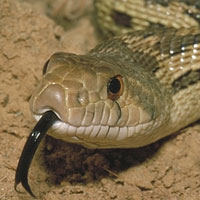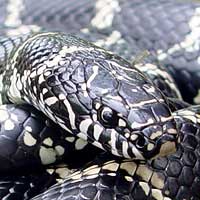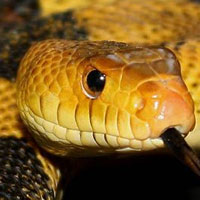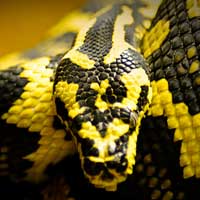Everything You Need to Know About the Gray Rat Snake
The Gray Rat Snake, scientifically known as Pantherophis spiloides, belongs to the Colubridae family, which is the largest family of snakes, comprising a wide variety of non-venomous and mildly venomous species known for their adaptability and extensive geographic range.
Scientific Name: Pantherophis spiloides
Snake Family: Colubridae
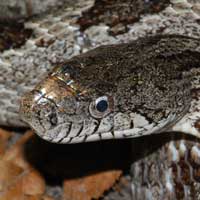
Introduction to the Gray Rat Snake
The Gray Rat Snake (*Pantherophis spiloides*), also known as the Midland Rat Snake, is a non-venomous species native to North America. Recognized for its adaptability and calm demeanor, the Gray Rat Snake is a popular choice among reptile enthusiasts. With its striking gray pattern and manageable size, this snake thrives in captivity, making it a suitable pet for beginners and experts alike.
Designing the Perfect Habitat for the Gray Rat Snake
The Gray Rat Snake’s natural habitat spans forests, fields, and rocky areas. To replicate these conditions in captivity, follow these guidelines:
- Enclosure Size: Provide a minimum of a 40-gallon tank for adults, ensuring it is escape-proof.
- Temperature Gradient: Maintain daytime temperatures of 75-85°F with a basking spot at 90°F, and nighttime temperatures of 65-75°F.
- Humidity: Keep humidity levels between 40-60% with occasional misting.
- Substrate: Use aspen shavings, cypress mulch, or a sand-soil mix to mimic their natural environment.
- Enrichment: Include climbing branches, rocks, and hides to encourage natural behaviors like climbing and burrowing.
Refer to the table below for a quick reference guide:
| Habitat Element | Specifications |
|---|---|
| Enclosure Size | 40+ gallons |
| Temperature | 75-85°F (day), 65-75°F (night) |
| Humidity | 40-60% |
| Substrate | Aspen shavings, cypress mulch, sand-soil mix |
Feeding the Gray Rat Snake: What You Need to Know
The Gray Rat Snake is a carnivorous species with simple dietary needs. Key feeding tips include:
- Juveniles: Feed pinky mice every 5-7 days.
- Subadults: Offer small to medium-sized mice every 7-10 days.
- Adults: Provide adult mice or small rats every 10-14 days.
- Prey Type: Use pre-killed prey to prevent injuries during feeding.
- Hydration: Ensure a fresh supply of water in a shallow dish for drinking and soaking.
Consistent feeding schedules promote healthy growth and vitality in your snake.
Behavior and Temperament of the Gray Rat Snake
The Gray Rat Snake is known for its calm and inquisitive nature. Understanding its behavior is key to providing optimal care:
- Diurnal Activity: These snakes are primarily active during the day, making them engaging to observe.
- Climbing Abilities: They are excellent climbers and benefit from vertical space in their enclosure.
- Temperament: Generally docile, they tolerate handling well with regular interaction.
- Defensive Behavior: When threatened, they may vibrate their tail or emit a harmless musk, but biting is rare.
Creating a stress-free and enriched environment enhances their natural behaviors and temperament.
Health and Lifespan of the Gray Rat Snake
With proper care, the Gray Rat Snake can live 15-20 years in captivity. Key health considerations include:
- Common Health Issues: Respiratory infections, shedding problems, and external parasites like mites.
- Preventative Measures: Maintain stable environmental conditions and clean the enclosure regularly.
- Veterinary Care: Schedule regular check-ups with an exotic animal veterinarian to ensure early detection of potential issues.
- Observation: Monitor for signs of illness, such as lethargy, loss of appetite, or unusual behavior.
Attention to detail in their care helps ensure a long and healthy life for your snake.
Reproduction and Breeding of the Gray Rat Snake
Breeding Gray Rat Snakes in captivity requires replicating their natural reproductive cycle. Important aspects include:
- Breeding Season: Occurs in spring after a winter brumation period.
- Clutch Size: Females typically lay 6-12 eggs per clutch.
- Incubation: Eggs should be incubated at 80-85°F for 50-60 days.
- Hatchlings: Provide appropriately sized enclosures and prey for juveniles once hatched.
Proper preparation and monitoring are essential for successful breeding.
Handling and Caring for the Gray Rat Snake
Handling and caring for the Gray Rat Snake is straightforward with proper techniques. Follow these tips:
- Handle your snake gently, supporting its entire body to minimize stress.
- Avoid handling immediately after feeding to prevent regurgitation.
- Keep the enclosure clean and provide enrichment to mimic natural behaviors.
- Monitor their health and behavior regularly for signs of stress or illness.
- Establish a routine for feeding, cleaning, and handling to ensure consistency.
With proper care and handling, the Gray Rat Snake can become a rewarding and low-maintenance pet.
Other Snakes In This Species
 Aesculapian Rat Snake
Aesculapian Rat Snake Amur Russian Rat Snake
Amur Russian Rat Snake Bairds Rat Snake
Bairds Rat Snake Black Rat Snake
Black Rat Snake Chinese Twin-spotted Rat Snake
Chinese Twin-spotted Rat Snake Diadem Rat Snake
Diadem Rat Snake Diones Rat Snake
Diones Rat Snake Eastern Fox Snake
Eastern Fox Snake Everglades Rat Snake
Everglades Rat Snake Four-lined Rat Snake
Four-lined Rat Snake Gray Rat Snake
Gray Rat Snake Great Plains Rat Snake
Great Plains Rat Snake Green Rat Snake
Green Rat Snake Ladder Rat Snake
Ladder Rat Snake Leopard Rat Snake
Leopard Rat Snake Mandarin Rat Snake
Mandarin Rat Snake Radiated Rat Snake
Radiated Rat Snake Steppes Rat Snake
Steppes Rat Snake Texas Rat Snake
Texas Rat Snake Trans-Pecos Rat Snake
Trans-Pecos Rat Snake Trinket Rat Snake
Trinket Rat Snake Yellow Rat Snake
Yellow Rat Snake



